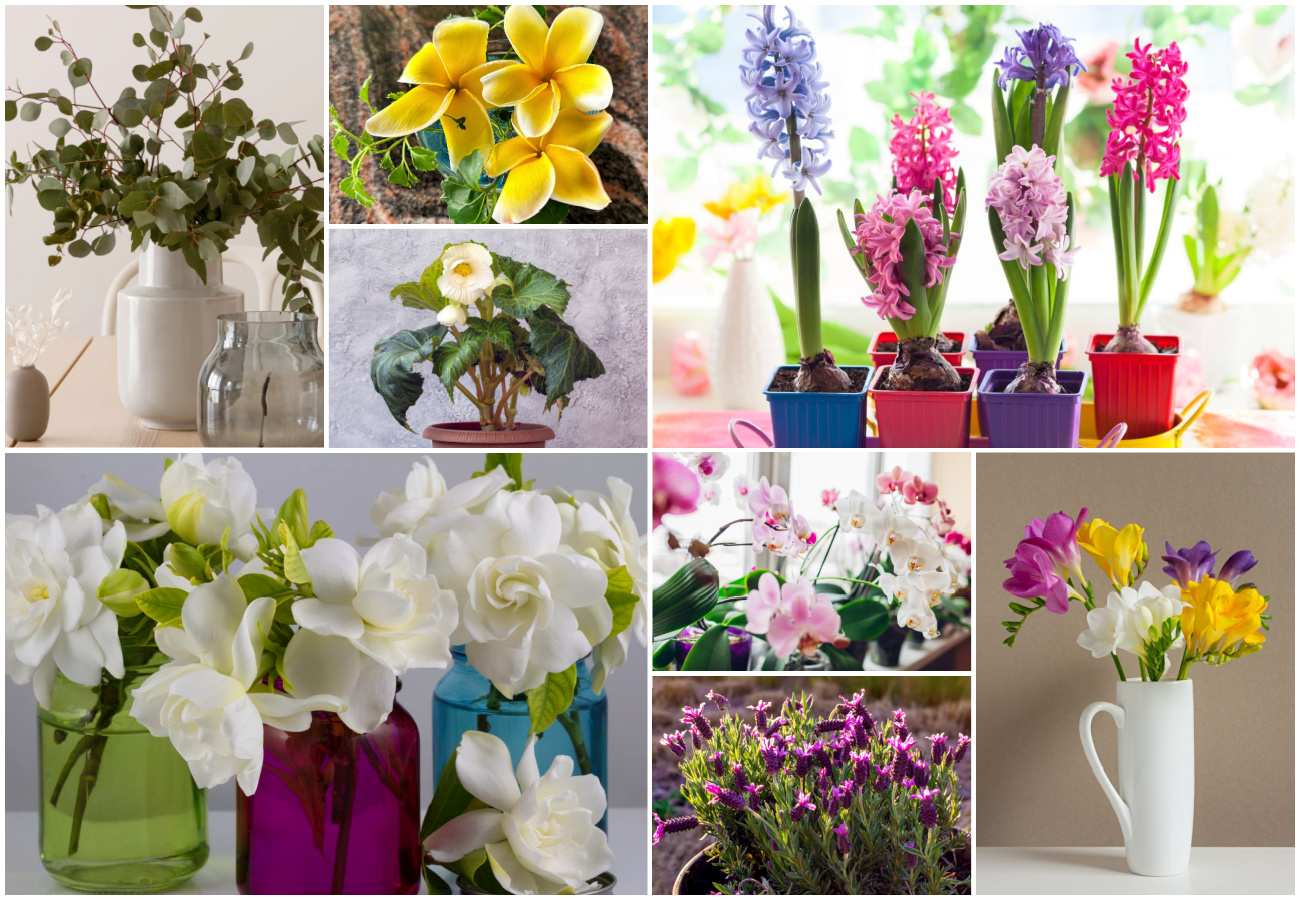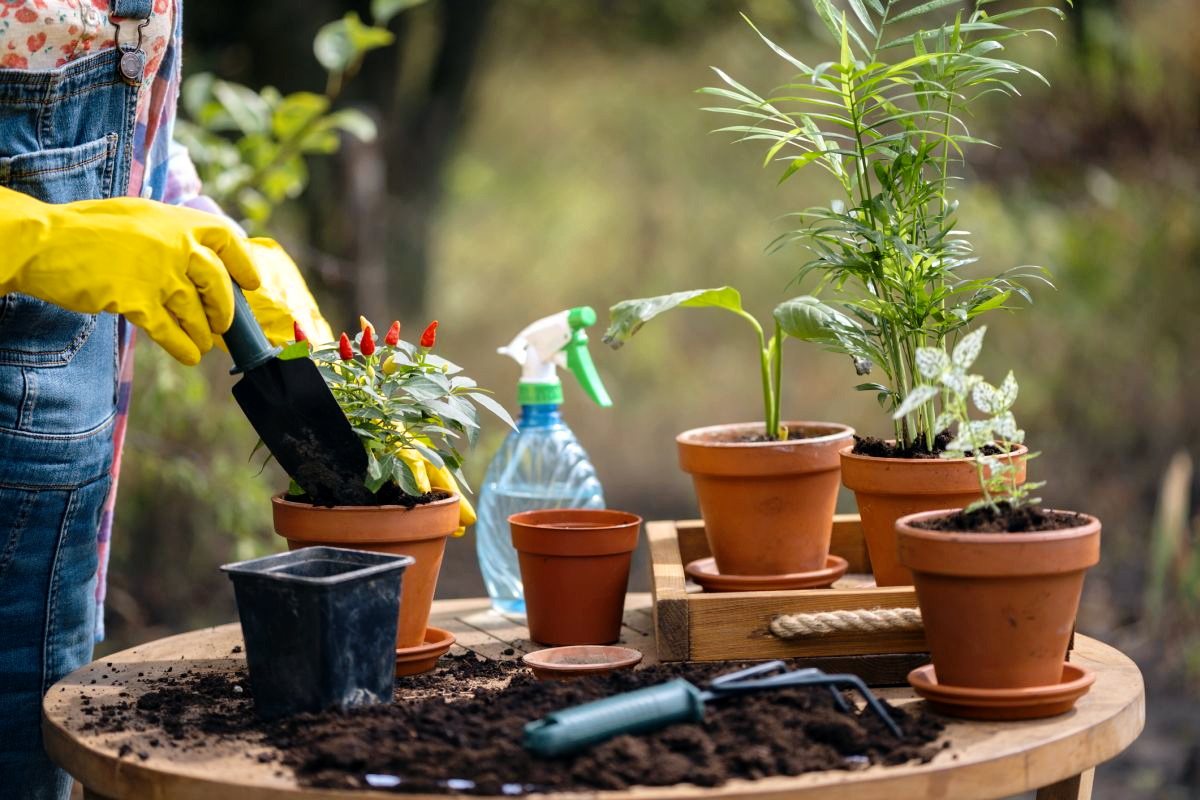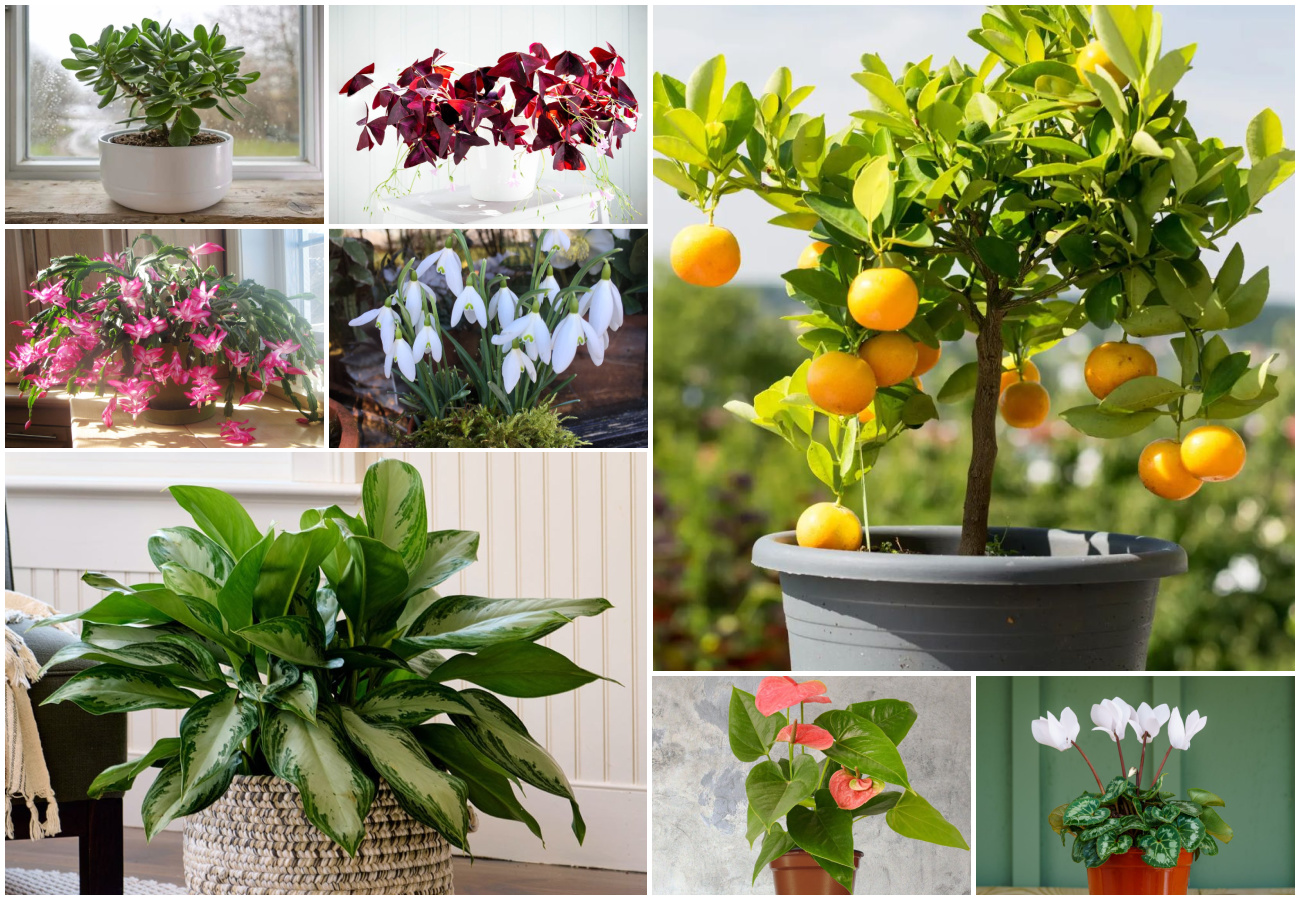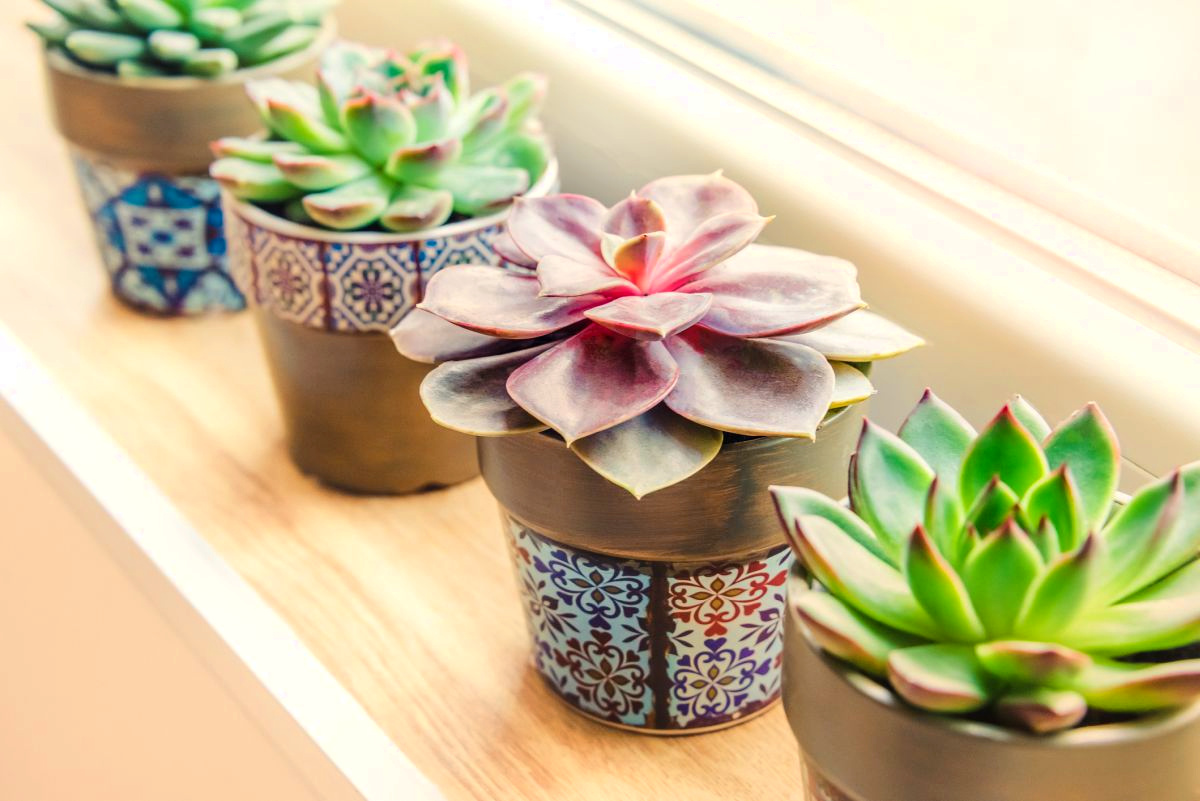Is your string of pearls (Curio rowleyanus, previously Senecio rowleyanus) succulent not looking its best? You’re not alone. Even many seasoned houseplant enthusiasts struggle with this decorative but notoriously fussy species.
Below, we’ll go into 6 common issues with string of pearls, their causes and how to troubleshoot. Let’s figure out what’s wrong and get your plant back on track!
Note: The tips in this article roughly apply to most ‘string of’ succulents in the genus Curio (which formerly belonged to the genus Senecio), not just the string of pearls (Curio rowleyanus).
If your string of dolphins (Curio x peregrinus), string of bananas (Curio radicans) or string of watermelons (Curio herreanus) is looking a bit rough, continue reading.
Tip: Did you come here looking for information on caring for a string of pearls? This is a troubleshooting guide. Head over to the full string of pearls care guide instead!
String of pearls shriveling
Symptoms: Shriveled leaves
Causes: Underwatering or overwatering
This is probably the symptom I get asked about most often. The plant’s leaves, or “pearls” become smaller and wrinklier as they lose water, eventually ending up tiny, crispy, brown and profoundly dead. This tends to start at the top of the plant and move gradually downwards until nothing is left.
Shriveled leaves on a string of pearls indicate a lack of moisture. Annoyingly enough, though, this can actually be caused by both under- and overwatering. That’s what makes it such a headache! You’ll have to figure out which one it is, so have a look below and click through to the appropriate section to find out what measures to take.
You may be underwatering. Is the soil bone dry and has it been a while? Or is it possible you’re watering regularly, but dealing with soil compaction preventing water from reaching the roots? If you suspect this might be the case, head to the section on underwatered string of pearls.
Is the soil not dry and do you water regularly? You may be overwatering. This, especially when combined with other factors like a lack of drainage, can easily cause root rot in a string of pearls.
When the roots die off, this can result in shriveled leaves due to a lack of moisture. After all, the plant is now unable to take up water. If you suspect this might be the case, head to the section on overwatered string of pearls.

Overwatered string of pearls
Symptoms: Burst leaves, shriveled leaves, yellowing/blackening leaves, unpleasant odor
Causes: Overenthusiasm, potting mixture, drainage
Overwatering is the most common cause of death for houseplants in general. Many of us tend to really overestimate the amount of water an indoor plant needs! Succulents aren’t afraid of a little water, especially during summer, but their soil needs to be able to dry out between waterings or the roots can quickly start to suffer.
Overwatering symptoms & causes
An overwatered string of pearls will just look… not well. Leaves and stems might be mushy, brownish, yellow or blackened, burst and shriveled. The soil will likely be damp and may even emit a bad smell. Clear signs of root rot, possibly progressed to stem rot, which needs immediate attention.
And keep in mind that it’s not just “watering too much too often” that causes overwatering symptoms like root rot. Other factors include:
- The planter lacks a drainage hole.
- The soil doesn’t drain well enough, staying wet for too long.
- Your plant isn’t getting enough light, making it unable to take up water.
- It’s winter and your plant doesn’t need as much water as it did in summer.
Overwatering treatment
If you suspect root rot due to having overwatered your string of pearls, you’ll unfortunately have to uproot your plant. Spread the soil and stems on some newspaper and have a look. Mushy roots? Blackening? Smelly? Damp soil? Yep, that’s rot.
It’s unfortunate, but ALL the afflicted parts of the plant have to go. Otherwise, the rot will spread until there’s nothing left of your succulent. Head over to the guide on propagating string of pearls to find out how to salvage what you can.
Re-plant the cuttings in a more well-draining soil that contains plenty of gritty material like perlite. Go for a planter with a drainage hole, provide lots of light and adjust your watering habits if need be. Remember: it’s almost always better to underwater than to overwater. If you’re not sure, wait another day.
Did you know? If it’s winter, is it possible your string of pearls was exposed to frost? The symptoms can mimic those of overwatering: blackening, burst leaves and general mushiness.
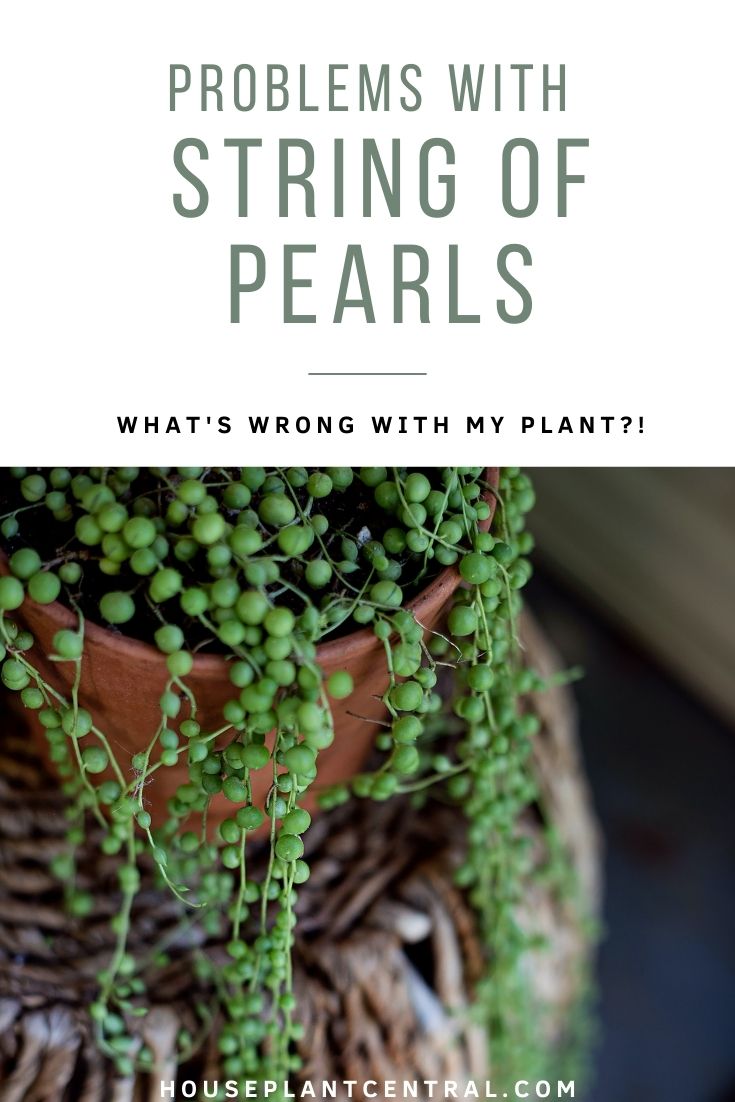
Underwatered string of pearls
Symptoms: Shriveling, crispy leaves/stems
Causes: Too little water, soil compaction
As discussed in the article on watering succulents, these plants can store water in their leaves, but that doesn’t mean they don’t need regular watering. In summer especially, indoor ones might need a drink up to once a week. Water generously once the soil is fully dry, though make sure the excess moisture can drain.
So what should you do if you spot shriveled leaves on your string of pearls and suspect it has been underwatered?
- Check the soil by poking a finger into it.
- Damp soil? The symptoms may actually have been caused by overwatering. Follow the instructions in the paragraph above. You’ll likely have to uproot the plant to check the state of the roots.
- Dry soil? Wet thoroughly until the water runs out of the drainage holes. Check the next day whether the pearls have plumped back up. If yes, water a bit earlier next time, you just waited too long.
- Pearls still shriveled? It might be soil compaction. Keep reading.
Underwatering due to soil compaction
Yep, you heard that right! Underwatering can even occur if you water your string of pearls regularly. Succulents aren’t always planted in the best soil mixes, and ones that are heavy in peat or coco coir can compact when they dry out. When you water again, the compacted soil doesn’t actually absorb the moisture. The water just ends up flowing out of the drainage holes without ever reaching your plant’s roots.
If you think you may be dealing with a case of soil compaction, your best bet is to repot. Soak the soil ball in water to help release your plant from its suffocating prison with its roots more or less intact. Then, move it into a suitable succulent soil mixture.
Did you know? If you’re trying to root string of pearls cuttings, it’s not unusual for them to exhibit symptoms of underwatering for a while. They struggle to take up enough moisture until their root system develops properly.
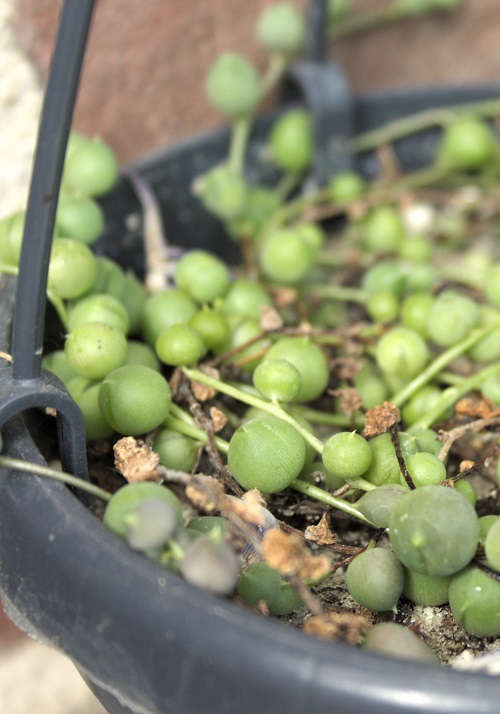
Sunburned string of pearls
Symptoms: Faded, yellow-reddish leaves
Causes: Too much sun without acclimation
It’s important to provide plenty of light if you want your string of pearls to thrive. This includes direct sun, especially indoors where light is much scarcer! They definitely don’t mind even some harsher afternoon rays.
However, what you need to keep in mind is that all plants need to be acclimated slowly to higher light conditions. If your string of pearls has spent a lot of time in a shadier spot, move it to its new position gradually, over the course of a few weeks. This prevents leaf discoloration and an angry plant.
If the damage is already done, all you can do is provide your plant with the usual string of pearls care and keep your fingers crossed. Some of the affected leaves may fall off, but the plant itself should usually bounce back fine.
Did you know? Overfertilization can also cause leaf discoloration like yellowing or browning. These plants appreciate a pinch of succulent fertilizer during the growing season, but too much can burn their roots and mess with their foliage. If you think you overfertilized, you can flush the soil with distilled water.
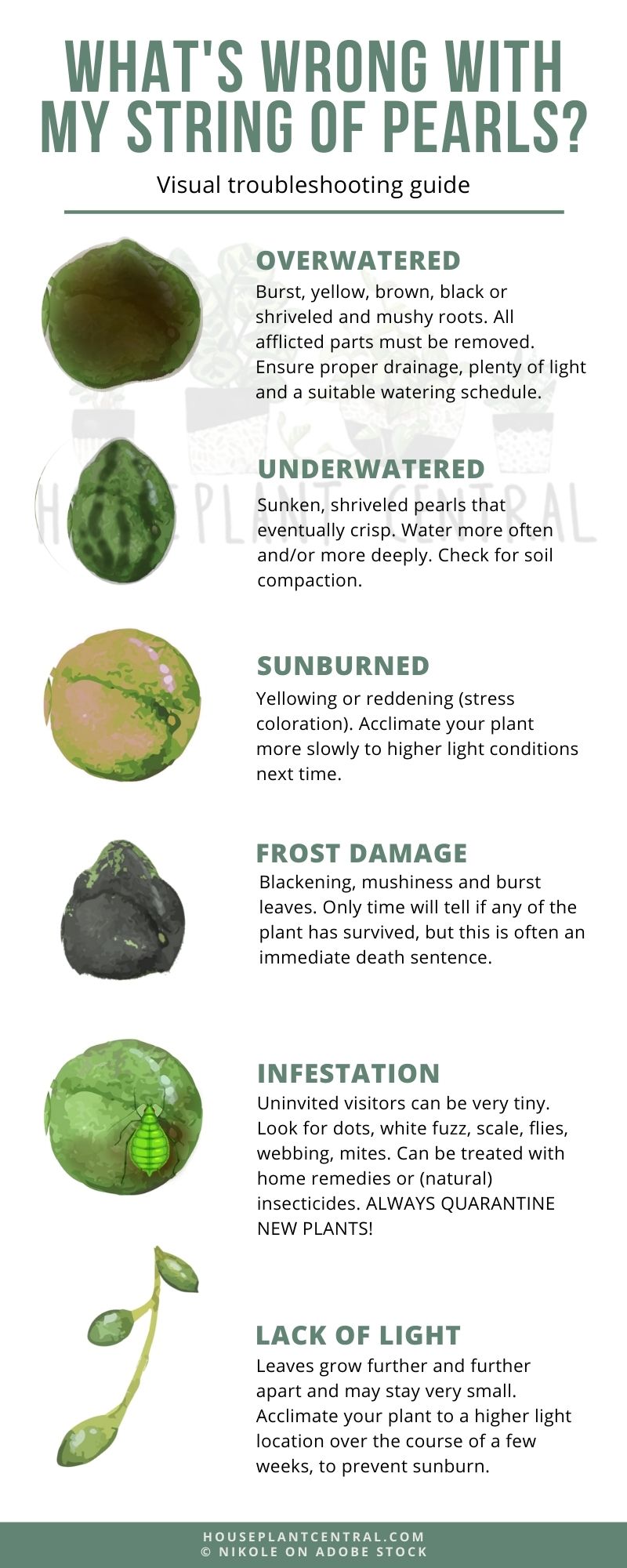
Bugs on string of pearls
Symptoms: Dots or fuzz, discoloration, shriveling, plant looks unhappy
Causes: Infestation
If your string of pearls is not looking its best, it’s always helpful to whip out a magnifying glass and check for bugs. There are plenty of creepy crawlies that feel right at home in our plants, sucking their juices: mealybugs, aphids, thrips, scale, spider mites and more.
Spotted some unwanted visitors on your string of pearls? First off, separate it from other plants immediately. Any neighbors should be monitored closely to see if the infestation spread to them (or if they were the source, who knows!). Start treatment with a home remedy like water/dish soap/neem oil mixtures or go for a gentle natural insecticide.
Tip: Always quarantine new plants and check them thoroughly for bugs. Trust me, you’ll be so glad you did it when you find an infestation that could have spread to all your other greenery!
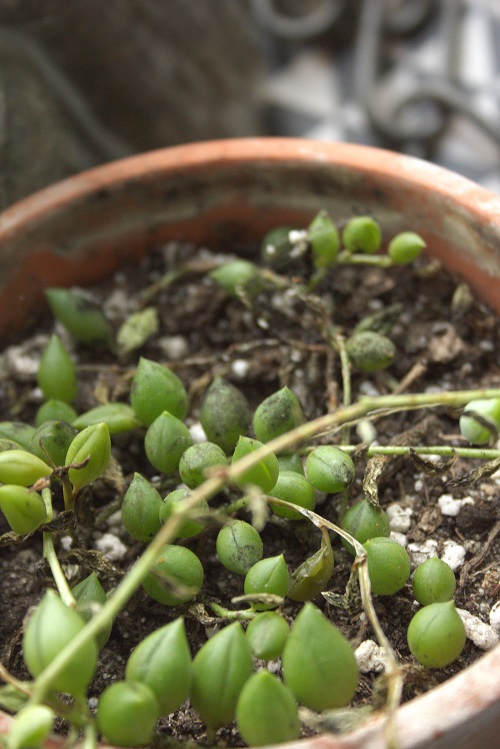
Stretched string of pearls
Symptoms: New leaves growing far apart and staying small
Causes: Lack of light
Just as us houseplant enthusiasts tend to overestimate the amount of water our greenery needs, we also tend to underestimate plants’ light needs. Succulents like a string of pearls really do like things bright. If you’ve tried to use yours to brighten up a spot in your home that isn’t right next to a window and you’re not using artificial lighting as a supplement, it’ll start looking scraggly.
There is no way to change existing growth on a plant. To avoid your string of pearls from getting sparser and sparser, acclimate it to a higher-light place. You can cut unsightly stems and place them back in the planter. This makes for a fuller look without the unsightly scraggly bits being too ‘in-your-face’.
Remember that this is not among the easiest houseplants. If yours doesn’t make it in the end, well, at least you learned something! And don’t forget: if it dies within a few weeks, it might have been the plant store’s fault, not yours. It could already have been overwatered, for example.

